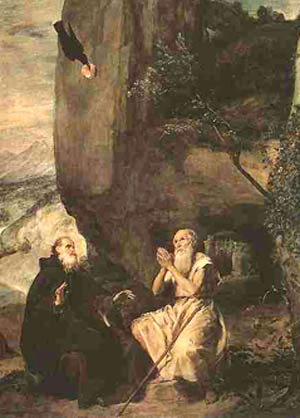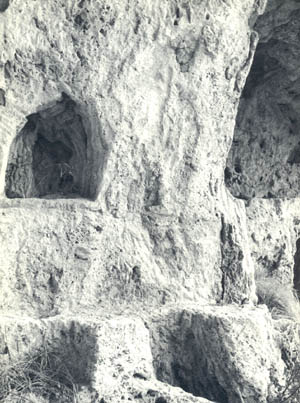 |
The Saint of the Day
St. Paul the Hermit – January 15
Prof. Plinio Corrêa de Oliveira
Biographical selection:

St. Anthony visits St. Paul in the desert, by Velasquez
|
St. Paul (229-342) was born in Lower Thebaïd, Egypt. At age 22 during the persecution of Emperor Decius, he learned that his brother-in-law, who wanted to confiscate his estate, was planning to report him as a Christian to the pagan authorities. Paul fled, taking refuge in the desert. After the danger abated, he decided to remain a hermit.
At the end of his life, St. Anthony visited him in his cave in the desert and found an exemplar of what a holy man should be. He lived as an anchorite for more than 90 years.
His life in the desert, however, should not lead us to think that the contemplation of God left him uninterested in the glorious battles of the Church. No one walks securely on the road leading to God if he is not united to the Spouse whom Christ chose and established as the column and fundament of Truth. Among the children of the Church, those called to be most closely united to her are the contemplatives, since they traverse the sublime, arduous roads where many dangers lurk.
From the depths of his cave, Paul, enlightened by divine inspiration, followed the battles of the Church against Arianism. He was an admirer of St. Athanasius and united to those who defended that the Word was co-substantial with the Father. He asked St. Antony, to whom he left his own tunic, to bury him with the tunic of St. Athanasius, which St. Antony had received as a gift from the Patriarch of Alexandria.
Comments of Prof. Plinio:
These are good commentaries on St. Paul, the first hermit. The selection focuses on the nobility of the eremitic state, which consists of living alone in the desert making elevated meditations that seem far removed from human affairs, and, therefore, from the fight between Good and Evil.

The ermitic life is sublime, but not easy.
Above, St. Anthony is tormented by devils in the desert.
|
Actually, the personal fight of the hermit between his ordered passions directed by reason and his disordered passions directed by the Devil are not antithetical to the fight. The selection clearly shows that those contemplative hermits, by special enlightenment from God, had a clear notion of the merit of the fight of the Church in their times.
The contemplative and active lives are profoundly harmonic, which can be seen in the life of St. Paul the Hermit. From the depths of his cave where he lived isolated and dedicated to meditating on the things of God, he also followed in spirit the battles of the great St. Athanasius. When he died, he asked to be buried in the tunic of St. Athanasius to manifest his enthusiasm for the battles that the great warrior was waging against Arianism. This episode illustrates how the external apostolate is linked to the interior life, how the active life is linked to the contemplative.
There is yet another consideration that can be made about the eremitic state. When speaking of it, one usually emphasizes the sacrifice and strength of will it takes to separate oneself from earthly things and be alone. In effect, the desire to talk and be with others is never so strong as when one is alone. Human nature is made in such a way that when we are with others for a long time, we want to be alone; but after we are alone for a time, we want to be among others. So, one of the greatest glories of the eremitic state would be to live alone and in silence.

Remains of hermit caves close to Subiaco, Italy
|
This is true in a certain way. But there is another aspect of the eremitic state to consider. Its nobility lies not just in remaining silent, but also in speaking with God. Speaking with God should be understood not as having continuous apparitions and revelations, but in keeping the spirit occupied with things of God, profound thoughts, elevated aspirations, noble causes. It is to be familiar with the highest cogitations of the human spirit, which are religious thoughts. This is, in my opinion, the excellence of the eremitic state, what constitutes its principal adornment and highest respectability.
From a certain point of view, a man in the eremitic state practices the virtue of respect above all others. For the hermit nothing is small, without importance, or trivial. He understands the highest reasons for which each thing was created and its sacred, august character. When he speaks, his voice is like a bronze bell, grave and serious, calling men to the highest cogitations of the spirit.
This is what the modern world is lacking more than anything else. The modern man completely lacks the virtue of respect. He lacks respect for himself and things because he rejected this spirit and embraced triviality and banality. He only likes transitory, concrete things that offer an immediate pleasure.
The eremitic state is, on the contrary, a way of living where a man is like a flaming torch of gravity and respect. Respect for God, above all, but also respect for himself and for every created thing as it reflects God. This is what I think is the glory of the eremitic state.
We should ask St. Paul the Hermit to pray for us to have an understanding of and desire for this virtue, because without the virtue of respect, neither moral perfection nor sanctity exists.


  | | Prof. Plinio Corrêa de Oliveira | |
The Saint of the Day features highlights from the lives of saints based on comments made by the late Prof. Plinio Corrêa de Oliveira. Following the example of St. John Bosco who used to make similar talks for the boys of his College, each evening it was Prof. Plinio’s custom to make a short commentary on the lives of the next day’s saint in a meeting for youth in order to encourage them in the practice of virtue and love for the Catholic Church. TIA thought that its readers could profit from these valuable commentaries.
The texts of both the biographical data and the comments come from personal notes taken by Atila S. Guimarães from 1964 to 1995. Given the fact that the source is a personal notebook, it is possible that at times the biographic notes transcribed here will not rigorously follow the original text read by Prof. Plinio. The commentaries have also been adapted and translated for TIA’s site.
|
Saint of the Day | Home | Books | CDs | Search | Contact Us | Donate

© 2002- Tradition in Action, Inc. All Rights Reserved
|
 |
|